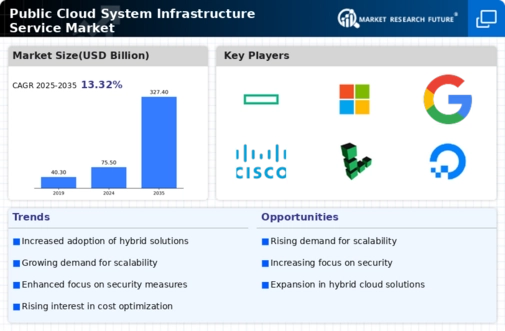Rising Demand for Scalability
The Public Cloud System Infrastructure Service Market experiences a notable increase in demand for scalable solutions. Organizations are increasingly seeking infrastructure that can adapt to their fluctuating needs, allowing for seamless expansion or contraction of resources. This trend is driven by the necessity for businesses to remain agile in a competitive landscape. According to recent data, the market for scalable cloud services is projected to grow at a compound annual growth rate of approximately 22% over the next five years. This growth indicates a strong preference for cloud solutions that can efficiently accommodate varying workloads, thereby enhancing operational efficiency and reducing costs. As companies continue to migrate to cloud-based infrastructures, the emphasis on scalability becomes a pivotal factor in their decision-making processes.
Cost Efficiency and Budget Optimization
Cost efficiency remains a critical driver in the Public Cloud System Infrastructure Service Market. Organizations are increasingly recognizing the financial advantages of adopting cloud solutions over traditional on-premises infrastructure. By leveraging cloud services, businesses can significantly reduce capital expenditures associated with hardware and maintenance. Recent analyses suggest that companies can save up to 30% on IT costs by transitioning to cloud-based systems. This financial incentive is compelling, particularly for small to medium-sized enterprises that may have limited budgets. Furthermore, the pay-as-you-go model offered by many cloud providers allows organizations to optimize their budgets, ensuring they only pay for the resources they utilize. This flexibility in financial management is likely to continue driving the adoption of public cloud services.
Technological Advancements and Innovation
Technological advancements play a pivotal role in shaping the Public Cloud System Infrastructure Service Market. The rapid evolution of technologies such as artificial intelligence, machine learning, and edge computing is driving innovation within cloud services. These advancements enable organizations to harness the power of data analytics and improve operational efficiencies. For instance, the integration of AI into cloud infrastructure allows for predictive analytics, which can optimize resource allocation and enhance performance. Market data suggests that the adoption of AI-driven cloud solutions is expected to grow by over 30% in the coming years. This trend indicates a strong inclination towards leveraging cutting-edge technologies to gain a competitive edge. As organizations continue to seek innovative solutions, the impact of technological advancements on the public cloud infrastructure will likely intensify.
Regulatory Compliance and Data Sovereignty
Regulatory compliance is a significant driver in the Public Cloud System Infrastructure Service Market. Organizations are increasingly required to adhere to stringent data protection regulations, which necessitate the implementation of compliant cloud solutions. The rise of data sovereignty laws, which mandate that data be stored within specific geographical boundaries, has further complicated the landscape. As a result, cloud service providers are adapting their offerings to ensure compliance with these regulations. Recent statistics indicate that approximately 60% of organizations prioritize compliance when selecting cloud services. This focus on regulatory adherence not only mitigates legal risks but also enhances customer trust. Therefore, the alignment of cloud infrastructure with regulatory requirements is likely to remain a key consideration for businesses moving forward.
Enhanced Collaboration and Remote Work Capabilities
The Public Cloud System Infrastructure Service Market is witnessing a surge in demand for solutions that facilitate enhanced collaboration and remote work capabilities. As organizations increasingly adopt hybrid work models, the need for cloud-based infrastructure that supports seamless communication and collaboration becomes paramount. Data indicates that companies utilizing cloud services for collaboration experience a 25% increase in productivity. This trend underscores the importance of cloud solutions in enabling teams to work together effectively, regardless of their physical locations. The ability to access shared resources and applications in real-time fosters innovation and accelerates project timelines. Consequently, the emphasis on collaboration tools within the public cloud infrastructure is likely to persist, shaping the future of work.

















Leave a Comment